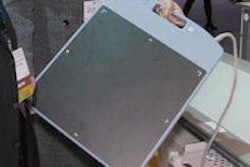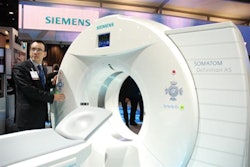ORLANDO - The Healthcare Information and Management Systems Society (HIMSS) is holding its annual meeting this week in the world's capital of wonder, magic, and make believe. The event is attracting what's expected to be a record crowd of up to 35,000 healthcare IT professionals to discuss what is increasingly becoming a reality: electronic health records (EHRs).
The theme of HIMSS11 is "Linking People, Potential and Progress." There are hundreds of educational sessions, lectures, workshops, forums, and roundtables to prove it, and to instruct healthcare providers in how to take the giant leaps forward to achieve the Obama Administration's goal of pushing healthcare recordkeeping and information sharing into the 21st century. Even U.S. Department of Health and Human Services (HHS) Secretary Kathleen Sebelius is attending the party.
Progress has clearly been made in a year.
What is glaringly missing, however, is the subject of imaging informatics. The significance of digital radiology and cardiology, pillars of patient treatment, and the complex issues relating their "meaningful use" and integration into the EHR once again are not being discussed at the Orange County Convention Center.
Exactly three HIMSS sessions, two of which are vendor-sponsored lectures held in the noisy exhibition halls, are about imaging informatics. The other is the sole educational session annually sponsored by the Society for Imaging Informatics in Medicine (SIIM), entitled "We Never Talk Anymore -- Communication in the Electronic Age."
This year, the HIMSS Interoperability Showcase fails to integrate imaging informatics into scenarios where its use can significantly contribute to clinical knowledge integration and information sharing. At a size of 40,000 sq ft, with more than 80 participating vendors and organizations, this is the largest and most complex demonstration in its 10-year history.
Unlike the 2010 showcase, which integrated the transfer and use of diagnostic images and radiology reports into several creative scenarios, HIMSS attendees who "experience the ultimate reality show in healthcare interoperability" can see a rerun of the 2010 demonstration of image transfer of a cervical spine radiograph. Another oft-repeated demonstration through the years showed how primary care physicians could access images at a remote hospital from their local electronic medical record.
One forward-looking demonstration did include the ability to review diagnostic images stored in a commercial personal health record by a patient.
The "imaging services" department of a hospital also gets involved in another HIMSS scenario in which images taken by a laparoscopic camera during a conventional colonoscopy are forwarded by a private practice gastrointestinal outpatient clinic. However, the important details of how a non-DICOM image would be added to a patient's radiology DICOM records were not mentioned.
Although not shown, when asked by AuntMinnie.com, the U.S. Department of Veterans Affairs (VA) demonstrators said that the military's virtual lifetime electronic record would include reports of mammograms and provide the ability to transfer any digital images stored in the VA's VistA Imaging archives.
The following were interoperability scenarios at HIMSS where imaging informatics could have been realistically included and would have contributed to an understanding of the value of imaging informatics:
Informed care at a vacation community -- In this demo, medical records are transferred from the patient's home healthcare provider to a hospital where the patient is vacationing. Radiology records were not included in this demonstration, even though they hypothetically could have included recent CT, CT angiography, and/or fluoroscopy exams that might have prevented unnecessary procedures from being ordered and performed by the remote hospital.
Adverse event reporting -- This drug safety-oriented demo included U.S. Food and Drug Administration (FDA) intervention. The demonstrators were interested in learning how this application could be used for either radiology or radiation oncology adverse events.
Physician cancer registry updating and utilization -- In spite of well-documented peer review interest in this data, radiation oncology treatment information was not included in the demonstration database.
Visualization of medical resources for emergency decision support -- This demo involved identifying the location of hospitals in geographic proximity to a large-scale disaster or incident. It also identified sources of medical supplies and availability of different types of inpatient beds (i.e., intenstive care unit, isolation, etc.). Identifying diagnostic imaging service capacity had not even been considered, although when the purpose of this was explained, the demonstrator thought it was an excellent idea.
No references were made about information sharing of the radiology records of children or the radiation oncology records of childhood cancer survivors. Ditto for adults.
AuntMinnie.com asked a number of demonstrators if they had ever heard of the Image Gently campaign's downloadable paper form for parents to keep records of their children's radiology exams. None had, but all said that would be a great application for a future interoperability showcase. In this context, nobody mentioned the words "imaging informatics."



















